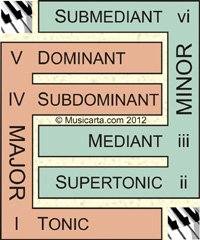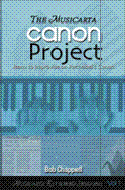Triad Shapes Drill
There are three simple triad shapes – root
position, first inversion and second inversion. These are different by virtue
of the different gaps between the chord tones. A trained musician, playing in a
particular key, will be able to find these three shapes, using that key’s scale
tones, either built on or hanging down from any of the key’s scale tones, ‘just
like that’.
The triad shapes drill is the kind of exercise
you would use to make sure you can do this. The drill has a simple formula –
you build the three possible triad shapes (root position, first inversion and
second inversion) built on eight scale tones ascending, and descending in
mirror image. There are two ‘types’ – two arrangements (orders) of these three
chords – plus a ‘mixed’ type.
The challenge, ‘in C’ (i.e. on the white keys) at least, is simply to keep going and getting it right. You ‘load the template’ and off you go. (When it comes to the mixed type, you have to think hard – skip it at first if you like.) But when you come to play the drill in D (two sharps) and B flat (two flats), it becomes much more about (i) knowing your keys, and (ii) doing everything required to get the fingers onto the keys – principally letting your hand go towards the back of the keys.
Don’t feel you have to play the whole exercise from start to finish. Mix it up a bit. Learn Type One ascending (Section 1) and play it in C, then in D (Section 7), then in B flat (Section 13), for example. Play with it! A ‘drill’ is by definition a mechanical exercise – but that doesn’t mean your brain will be switched off. To keep going and keep getting it right requires attention. Only awareness in activity extracts maximum benefit.
Don’t feel you have to play the whole
exercise from start to finish. Mix it up a bit. Learn Type One ascending
(Section 1) and play it in C, then in D (Section 7), then in B flat (Section
13), for example. Play with it! A ‘drill’ is by definition a mechanical
exercise – but that doesn’t mean your brain will be switched off. To keep going
and keep getting it right requires attention. Only awareness in activity extracts
maximum benefit.
Aside from the ‘generic’ benefit of keeping
going and getting it right, you should be training your ear at the same time.
You should be able to hear what the next chord in the pattern is going to sound
like, and particularly, to hear the ‘middle voice’ – the one that’s different
between Types One and Two. In your general modern pop style keyboard work, the
chord you will want in your right hand is probably one of these three. Playing
through this drill over and over again will increase the accuracy of you
‘educated guesswork’ as to which one it is.
Try to use sensible fingering – don’t always be running out. Use RH2 for the middle note of a first inversion chord, and 1, 2, 4 for a root position chord when ascending. Use the voice movement diagram above the scrolling music – the little three-line diagrams give you an ‘aerial view’ of how the notes in the triads move. Let the ‘square, circle, triangle’ convention sink in – eventually, this convention fast-tracks your finding the chords you need.
This is, admittedly, 'just a drill', but even if you only ever play it through once (with awareness!) in, say, the keys up to four sharps/flats, you will be a better pianist – for ever! It’s worth obsessing over something once in a while!
If you prefer to watch the video in the YouTube environment, here's the link.
Thanks for visiting MUSICARTA! Come again soon!
|
OUT NOW! |
THE MUSICARTA BEAT & RHYTHM WORKBOOK At last! An effective approach to keyboard rhythm & syncopation skills. Learn more! |
ONLY $24.95! |
THERead all |
|
|

The MusicartaA methodical approach to keyboard syncopation for
|
PUBLICATIONS
exciting keyboard
creativity courses
CHORDS 101
WORKBOOK

~HANON~
video course

Musicarta
Patreon
PENTATONICS
WORKBOOK
video course

Creative Keyboard
video course

BEAT AND RHYTHM
WORKBOOK

- Volume 1 -

12-BAR PIANO
STYLES WORKBOOK

MUSICARTA MODES
WORKBOOK

PIANO STYLE

CANON PROJECT
video course

VARIATIONS
video course


- Piano Solo -
video course

- Piano Solo -


YouTube playlists





 THE LOGO
THE LOGO



